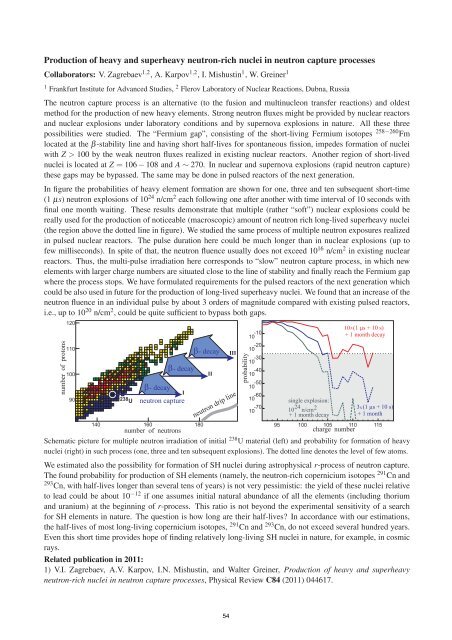FIAS Scientific Report 2011 - Frankfurt Institute for Advanced Studies ...
FIAS Scientific Report 2011 - Frankfurt Institute for Advanced Studies ...
FIAS Scientific Report 2011 - Frankfurt Institute for Advanced Studies ...
Create successful ePaper yourself
Turn your PDF publications into a flip-book with our unique Google optimized e-Paper software.
Production of heavy and superheavy neutron-rich nuclei in neutron capture processes<br />
Collaborators: V. Zagrebaev 1,2 , A. Karpov 1,2 , I. Mishustin 1 , W. Greiner 1<br />
1 <strong>Frankfurt</strong> <strong>Institute</strong> <strong>for</strong> <strong>Advanced</strong> <strong>Studies</strong>, 2 Flerov Laboratory of Nuclear Reactions, Dubna, Russia<br />
The neutron capture process is an alternative (to the fusion and multinucleon transfer reactions) and oldest<br />
method <strong>for</strong> the production of new heavy elements. Strong neutron fluxes might be provided by nuclear reactors<br />
and nuclear explosions under laboratory conditions and by supernova explosions in nature. All these three<br />
possibilities were studied. The “Fermium gap”, consisting of the short-living Fermium isotopes 258−260 Fm<br />
located at the β-stability line and having short half-lives <strong>for</strong> spontaneous fission, impedes <strong>for</strong>mation of nuclei<br />
with Z > 100 by the weak neutron fluxes realized in existing nuclear reactors. Another region of short-lived<br />
nuclei is located at Z = 106 − 108 and A ∼ 270. In nuclear and supernova explosions (rapid neutron capture)<br />
these gaps may be bypassed. The same may be done in pulsed reactors of the next generation.<br />
In figure the probabilities of heavy element <strong>for</strong>mation are shown <strong>for</strong> one, three and ten subsequent short-time<br />
(1 µs) neutron explosions of 10 24 n/cm 2 each following one after another with time interval of 10 seconds with<br />
final one month waiting. These results demonstrate that multiple (rather “soft”) nuclear explosions could be<br />
really used <strong>for</strong> the production of noticeable (macroscopic) amount of neutron rich long-lived superheavy nuclei<br />
(the region above the dotted line in figure). We studied the same process of multiple neutron exposures realized<br />
in pulsed nuclear reactors. The pulse duration here could be much longer than in nuclear explosions (up to<br />
few milliseconds). In spite of that, the neutron fluence usually does not exceed 10 16 n/cm 2 in existing nuclear<br />
reactors. Thus, the multi-pulse irradiation here corresponds to “slow” neutron capture process, in which new<br />
elements with larger charge numbers are situated close to the line of stability and finally reach the Fermium gap<br />
where the process stops. We have <strong>for</strong>mulated requirements <strong>for</strong> the pulsed reactors of the next generation which<br />
could be also used in future <strong>for</strong> the production of long-lived superheavy nuclei. We found that an increase of the<br />
neutron fluence in an individual pulse by about 3 orders of magnitude compared with existing pulsed reactors,<br />
i.e., up to 10 20 n/cm 2 , could be quite sufficient to bypass both gaps.<br />
Schematic picture <strong>for</strong> multiple neutron irradiation of initial 238 U material (left) and probability <strong>for</strong> <strong>for</strong>mation of heavy<br />
nuclei (right) in such process (one, three and ten subsequent explosions). The dotted line denotes the level of few atoms.<br />
We estimated also the possibility <strong>for</strong> <strong>for</strong>mation of SH nuclei during astrophysical r-process of neutron capture.<br />
The found probability <strong>for</strong> production of SH elements (namely, the neutron-rich copernicium isotopes 291 Cn and<br />
293 Cn, with half-lives longer than several tens of years) is not very pessimistic: the yield of these nuclei relative<br />
to lead could be about 10 −12 if one assumes initial natural abundance of all the elements (including thorium<br />
and uranium) at the beginning of r-process. This ratio is not beyond the experimental sensitivity of a search<br />
<strong>for</strong> SH elements in nature. The question is how long are their half-lives? In accordance with our estimations,<br />
the half-lives of most long-living copernicium isotopes, 291 Cn and 293 Cn, do not exceed several hundred years.<br />
Even this short time provides hope of finding relatively long-living SH nuclei in nature, <strong>for</strong> example, in cosmic<br />
rays.<br />
Related publication in <strong>2011</strong>:<br />
1) V.I. Zagrebaev, A.V. Karpov, I.N. Mishustin, and Walter Greiner, Production of heavy and superheavy<br />
neutron-rich nuclei in neutron capture processes, Physical Review C84 (<strong>2011</strong>) 044617.<br />
54
















